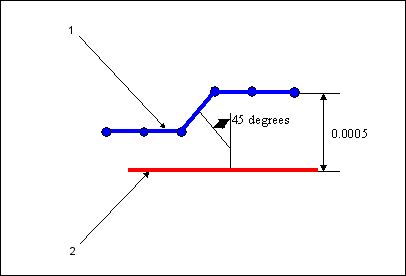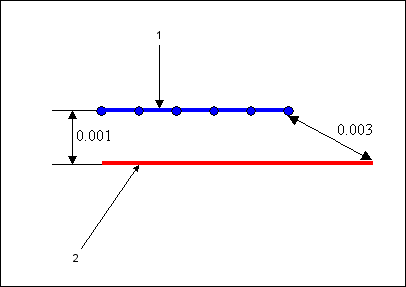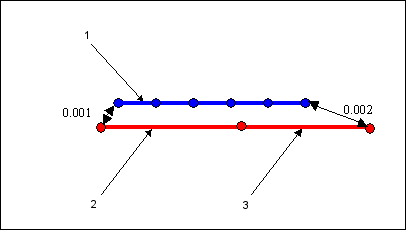Example: Auto-mapping an Imported Coefficient Mesh
You can use the
External Coefficients Field option in the
Pressure Load dialog box to import a FEM Neutral Format (FNF) file containing the imported mesh and coefficient field that specifies the spatial variation of the pressure load.
Creo Simulate can automatically map the imported coefficients to one or more surfaces of your model. The mapping is based on to two controlling tolerances - maximum distance and maximum angle. Creo Simulate selects a surface to map the imported mesh to, if all the points on the surface are within both the specified tolerances in the following manner:
• The distance between any point on the surface and the imported mesh must be equal to or less than the maximum distance.
• The angle between the vectors normal to the model's surface and the mesh surface must be less than the maximum angle.
The following examples show surfaces that qualify for automatic mapping and surfaces that do not. Tolerances of 0.0012 units (maximum distance) and 10

(maximum angle) are assumed in these examples. The imported FNF mesh is shown in blue while the model surface is shown in red.
The surface shown below satisfies both conditions, and qualifies for automatic mapping.
1. Imported FNF mesh
2. Model surface
In the next example though the surface meets the maximum distance criterion, it does not meet the maximum angle criterion at all points. This surface is not mapped automatically.
1. Imported FNF mesh
2. Model surface
Some points at the edge of the following model surface are further away than the specified maximum distance. This surface is not mapped automatically.
1. Imported FNF mesh
2. Model surface
In the following example, all points on model surface A satisfy the maximum distance criterion while some points on model surface B do not. Hence, only surface A qualifies for automatic mapping.
1. Imported FNF mesh
2. Model surface A
3. Model surface B
 (maximum angle) are assumed in these examples. The imported FNF mesh is shown in blue while the model surface is shown in red.
(maximum angle) are assumed in these examples. The imported FNF mesh is shown in blue while the model surface is shown in red. (maximum angle) are assumed in these examples. The imported FNF mesh is shown in blue while the model surface is shown in red.
(maximum angle) are assumed in these examples. The imported FNF mesh is shown in blue while the model surface is shown in red.


